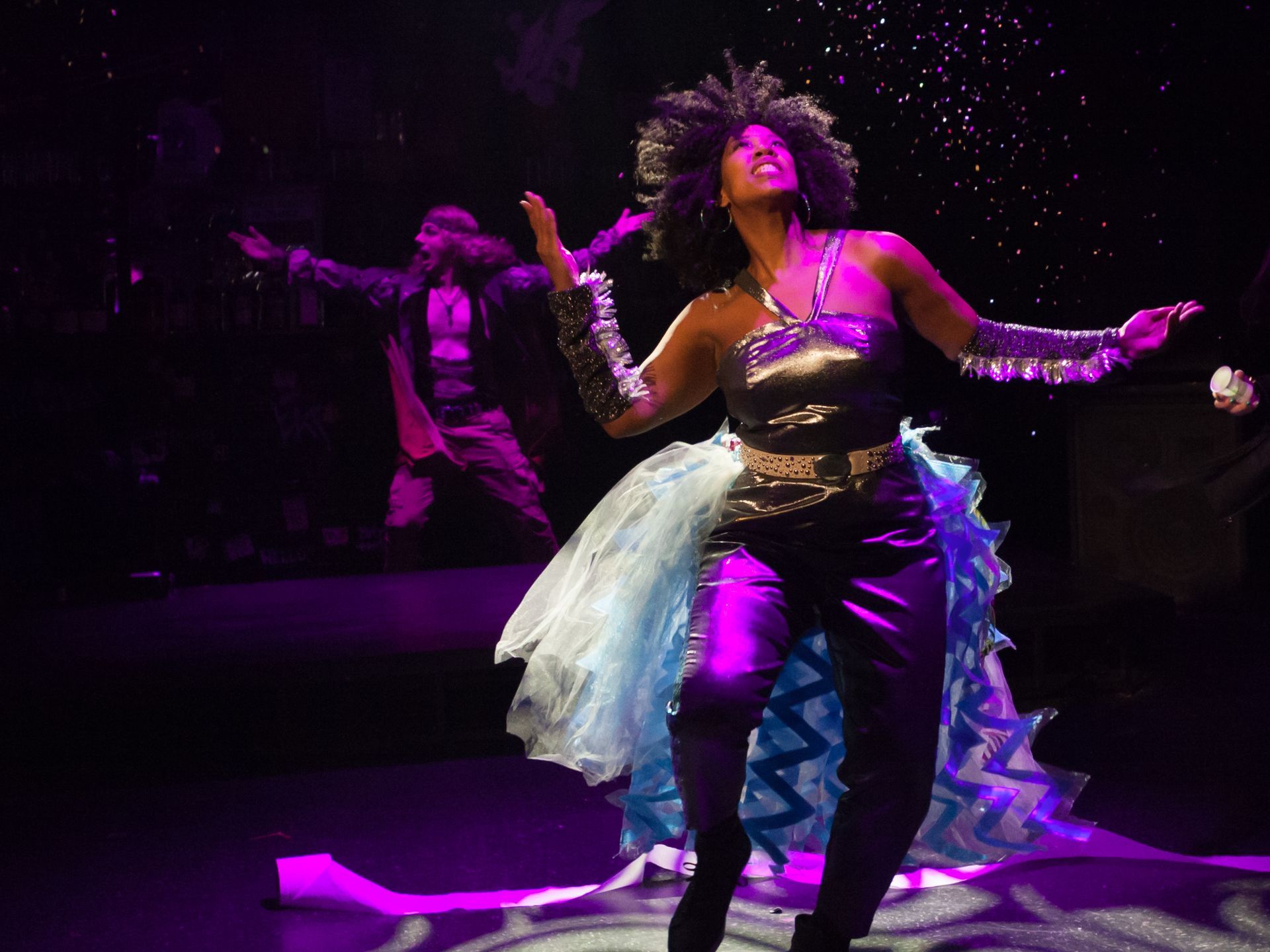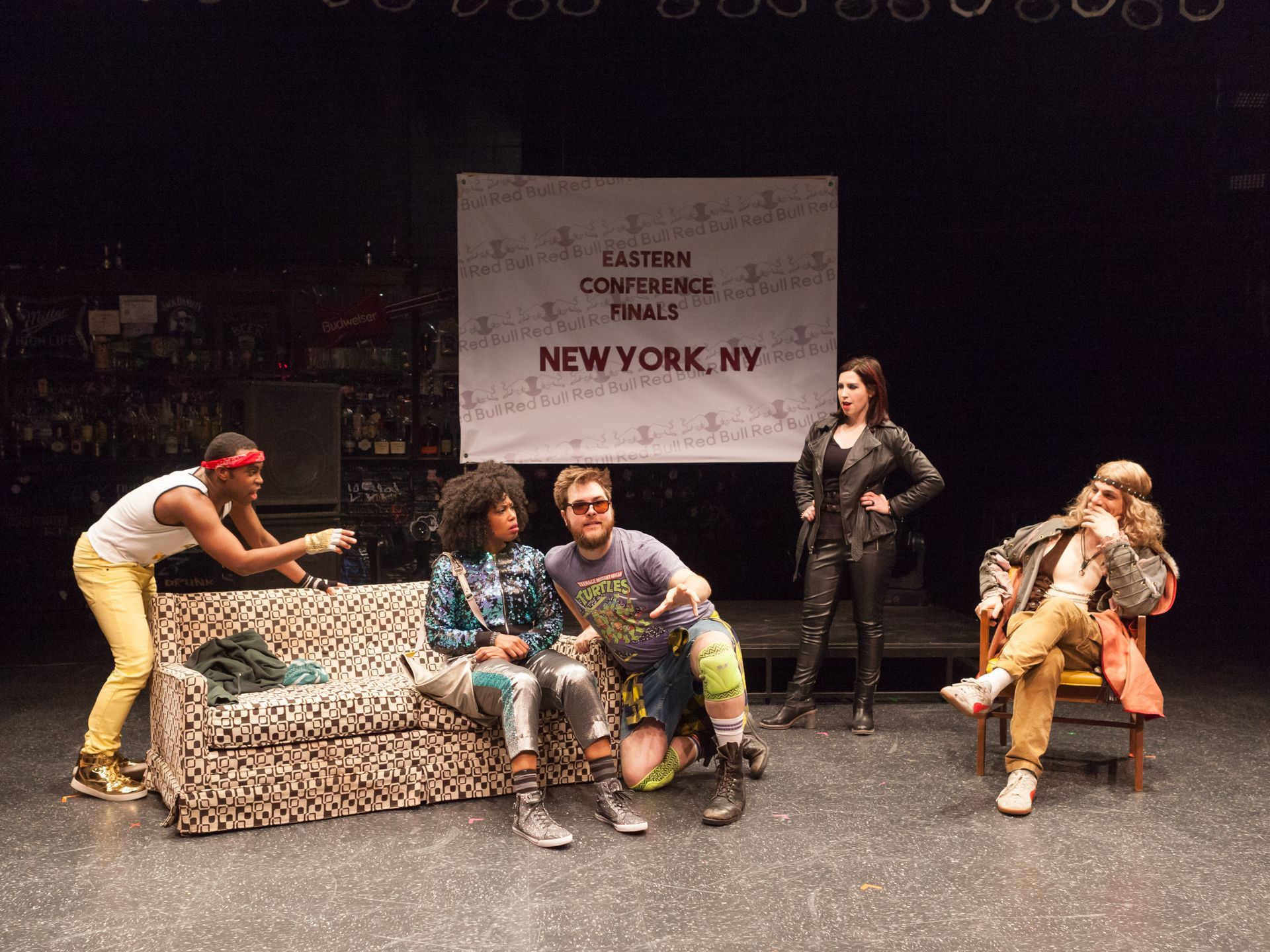by Mike Fischer, Special to the Journal Sentinel | Published April 3, 2017

Lucas Papaelias and Marinda Anderson in “Airness” by Chelsea Marcantel, part of the 2017 Humana Festival of New American Plays at Actors Theatre of Louisville. (photo by Bill Brymer)
LOUISVILLE, Ky. – The legion of happy souls out there playing air guitar – you know who you are – give voice to feelings for which we have no words. Air guitar is both irresistible and cause for embarrassment, which is why it’s usually done in private or when drunk. At least by most of us.
Those brave enough to give public expression to such personal impulses are called artists.
When those artists are air guitarists, they even compete in annual competitions, several of which form the backdrop for Chelsea Marcantel’s “Airness,” a fabulously fun piece that’s the best of the six full-length plays featured at the 41st Humana Festival of New American Plays concluding here on April 9.
Think of Humana as American theater’s Sundance Film Festival: attracting artistic directors and theater artists from around the world, it offers an early look at unknown plays and often less known playwrights, many of them ticketed for glory. The work staged here is directed, designed and acted by established theater artists from throughout the United States.
I predict great things for “Airness,” for reasons going well beyond its witty and informed discussion of the relationship between Tom Waits and the Ramones, or Nancy Wilson’s guitar technique.
As one of the memorable characters in “Airness” observes, what he and his fellow performance artists do “might be pretend. But it’s serious pretend.” Sort of like theater, in a show that doubles as a love song to all those stage actors toiling in relative obscurity and making too little money for their love of an art form that rarely gets its props but still makes them happy.
The world of air guitar that’s presented here gives us theater at its purest. As one of its practitioners explains to Nina “the Nina” O’Neal – a real guitarist but an air guitar novice – air guitar is democratic and non-commercial. It can’t be commodified; with the exception of this piece’s arch-villain, its practitioners aren’t for sale. They help each other, even as they compete.
All of them seek that nirvana-like state known as “airness,” in which they transcend imitating guitar greats and instead disappear into the original personae they’ve created as Cannibal Queen, Shreddy Eddy, Facebender, Golden Thunder and D Vicious. We also get to watch a young and lanky dude known as Matt Burns who is the 2016 World Air Guitar Champion. In “real” life.
Whatever that is. “When we’re here,” Facebender says at one point to Nina, “everything from outside here falls away.” Escapist? Sure. But with a marked anti-establishment bent, embodied by performers who exude integrity and heart. In aspiring to airness, they leave behind the normative rules and fears grounding the rest of us.
Ties That Bind
Focusing on marriage and the family, four of the remaining five plays feature characters who are unlikely to ever achieve airness, despite utopian aspirations of their own. Instead, they’re done in by marriage and family – even though, in some cases, they’d initially envisioned such structures as liberating.
In the opening scene of Tasha Gordon-Solomon’s “I Now Pronounce,” a presiding rabbi drops dead in the middle of the ceremony, sending the newlyweds into a tailspin and triggering a general discussion among them and a quartet of wedding party members regarding relationships.
Can one person ever be responsible for your entire happiness? Do we ask too much of marriage and each other? In a world where desire is unpredictable and relationships are therefore unstable, can marriage ever be more than a band aid, allowing us to stop the bleeding and keep ourselves together until death do us part?
If marriage can’t deliver airness, what about children?
Molly Smith Metzler’s “Cry it Out” – like Gordon-Solomon’s piece, a comedy – gives this question a class-based twist, as two new moms bond during maternity leave in their adjoining Long Island backyards.
Jessie (Jessica Dickey) is about to make partner in a big Manhattan law firm; brash and foul-mouthed Lina (Andrea Syglowski) works an entry-level hospital job. Jessie isn’t sure she’s going back to work; Lina has no choice.
Despite additional class-based differences involving childcare and how they see the future, the women take tentative steps toward friendship – in part because they’re both trapped by the Hobson’s choice confronting all mothers, in a country that won’t invest in paid family leave or subsidized daycare while imposing unrealistic, guilt-inducing expectations on every mom.
Nuclear Families
Basil Kreimendahl’s “We’re Gonna Be Okay” – one of the two remaining, more broadly focused and ultimately more successful variations on this theme of familial entrapment – takes place during the Cuban Missile crisis.
As with “Cry it Out,” “We’re Gonna Be Okay” features two neighboring families nevertheless differentiated by class. This time, it isn’t newborns that bring them together, but the bomb shelter they build on their property line, just in time for President Kennedy’s vow to stare down the Russians and their missiles.
But the bigger explosion threatening these two families involves that great awakening known as the 1960s, as two housewives wonder why they’re so unhappy, while two teens wrestle with their sexual identity and two husbands wonder what’s happened to the certainties they’d once known, involving loved ones morphing into strangers.
Jorge Ignacio Cortiñas’ “Recent Alien Abductions” takes such estrangement to an even more extreme place: It opens with a 25-minute monologue in which Álvaro (Jon Norman Schneider) invokes an episode of “The X-Files,” set in Álvaro’s own Puerto Rico, as a metaphor for his sense that he himself has been abducted by a family of aliens.
And no wonder: Álvaro’s family has become alien to him, propelling his flight to New York and ensuing efforts, there, to write his way out of the abuse he endured back home. We’re a long way from “Airness” in this dark and disturbing piece, but the two plays share the dream that we might transcend our circumstances – including our families – by making something new from what we inherit.
That’s also the theme of the final Humana show: “The Many Deaths of Nathan Stubblefield,” a collaboration involving four playwrights on a story cycle joining eleven vignettes, most of them focused on inventors from Kentucky. Like Stubblefield, the inventor more than a century ago of a prototype for the cell phone, they’re now unknown or forgotten.
Why?
In “Many Deaths,” the answer is often race or gender. In the final vignette, a black woman (Laakan McHardy) embodies the many thousands gone who never got the chance to make their mark, having lost their lives while chained in the fetid hold of a slave ship. Or working on a Kentucky plantation. Or living in the projects in Brooklyn.
It’s worth noting, in this context, that actors of color are well represented among the dueling air guitarists in “Airness,” as they are in general at Humana this year.
But in a lineup of plays continually driving home how hard it can be to transcend the entangling traps of one’s history, it’s clear that those achieving airness are the lucky ones. All too many would-be creators never get the chance to make such music on the fabulous instruments conjured by their minds.
The Humana Festival is held in Louisville annually from mid-March through early April. Read more about the Festival and this year’s play at https://actorstheatre.org/humana-festival-of-new-american-plays/. For my ranking of this year’s plays, go to TapMilwaukee.com.
Ranking the plays
Any effort to assess the plays one sees is inevitably partial, reflecting the inherently subjective nature of arts criticism. Bear that in mind while perusing the following list, in which I rank the six full-length shows at this year’s Humana Festival, ordered by preference and accompanied by capsule reviews.
1. “Airness” Chelsea Marcantel’s look at the world of air guitar competitions plays like a backstage drama about the hardworking and frequently underappreciated actors who make theater. Each of the six competitors is given sufficient air time to develop a distinct personality and matching performance style, and there’s just enough plot – including a love triangle – to propel things forward. It’s both funny and filled with heart, as every member of this merry band takes refuge from a real world in which they’re pigeonholed as losers. I was reminded of the superheroes in cosplay, expressing their collective belief in a better world while turning their back on this one (kudos to Chicago-based Alison Siple’s suburb costume design, which underscores this connection). I was also reminded of Mickle Maher’s “Spirits to Enforce,” as an ensemble of would-be superheroes is inspired by Shakespeare to save the world from narrowing greed – much as these air guitarists, inspired by rock legends, champion a view of art that dares to believe in the transformative power of the imagination.
2.“Recent Alien Abductions” Sandwiched by the otherwise unseen Álvaro’s two amazing monologues – smart, introspective, sardonically funny, and attuned to the relationship between culture and belief – the less successful middle section of Jorge Ignacio Cortiñas’ play portrays the family that destroyed him, triggering his flight from Puerto Rico and ensuing suicide in New York. The family members we meet in that section can play as caricatures, but that’s because they truly are monsters. Without overstating the case, Cortiñas draws parallels between the abuse endured by Álvaro and what Puerto Rico must endure from its big brother to the north.
3.“We’re Gonna Be Okay” Playwright Basil Kreimendahl profiles two neighboring families so focused on the Cold War abroad that they often miss the signs suggesting how rapidly things are heating up at home, where two desperate wives and two misfit teens try to make sense of a world they never made. With two exceptions – a working class dad and his teen daughter, terrifically played, respectively, by Scott Drummond and Anne-Marie Trabolsi – Kreimendahl’s characters rarely transcend their presentation as predictable types. But the dialogue among all six characters in this comedy is funny. Many of the scenes they share transcend the all-too familiar pattern of endlessly recurring two-person conversations. The play’s central conflict – between an outmoded vision of the American Dream and all the outsiders it stifles – is real and credibly presented.
4. “Cry It Out” The relationship in Molly Smith Metzler’s play between an upper-middle-class mother and a working-class mother is beautifully drawn, if also a bit idealized; one wishes working-class Lina would occasionally rip into the sometimes stunningly blind and naïve Jessie. Outspokenly brash as Lina is about everything else, it’s hard to believe she doesn’t. It’s also a bit disconcerting, in a play frequently so sensitive to issues of class, to see Metzler perpetuate class stereotypes (Lina, for example: She knows movies but not books, wears garish nail polish, is a recovering drug addict and drinker, has a mother-in-law who drinks wine from a box, etc.). One would like to see Metzler spend more time developing this relationship, especially if it means losing two more characters – even richer than Jessie and her husband – who are poorly but predictably drawn portraits of the super-rich, awkwardly stitched into the main story. Given this country’s cult of motherhood – simultaneously celebrated and scrutinized, here, by a playwright channeling a collective quandary about what work-life balance means – I’m guessing this play has a future. It’s reminiscent, in many ways, of Lisa Loomer’s “Living Out,” a better play about a similarly wealthy mother (and lawyer) as well as her working-class nanny.
5. “The Many Deaths of Nathan Stubblefield” When four playwrights collaborate on eleven vignettes, it’s not surprising that the result plays like a sometimes meandering and discombobulated cycle rather than a unified work. Many of those vignettes – all short, in a piece that only runs 90 minutes and has no intermission – are underdeveloped, pretentious, or both. But they collectively suggest that even history’s forgotten are just waiting for someone to tell their stories. And the best of them – including a piece on marginalized female inventors, a hip-hop-inflected look at a famous case involving racism in jury selection, and a final reminder of all those would-be creators who never got their shot, through no fault of their own – make clear why such stories matter.
6. “I Now Pronounce” Using a wedding mishap as her starting point, Tasha Gordon-Solomon wants to explore the way language, ritual and ceremony continually fail us when we need them most: to explain and stabilize our relationships, in a world where they frequently feel (and are) provisional. Instead we’re treated to a lot of forced sketch comedy that isn’t all that funny, involving characters who become their traits (a woman with boundary issues, a misogynist, a romantic, and so on). As a result, the audience is usually ahead of what’s happening on stage. The dialogue feels brittle. And because the characters aren’t real, they never grow. No wonder the end of “I Now Pronounce” repeats the beginning; it has one traveling in circles, from start to finish. My favorite feature in this play is a Greek chorus of three flower girls, guilelessly speaking truth in the way children usually do.







